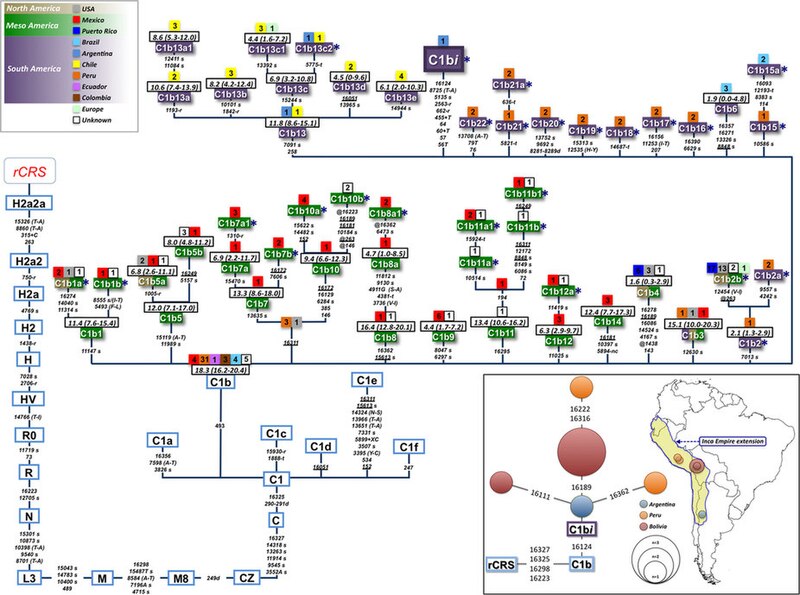File:Skeleton of the global mtDNA haplogroup C1b phylogeny.jpg
From Wikimedia Commons, the free media repository
Jump to navigation
Jump to search

Size of this preview: 800 × 595 pixels. Other resolutions: 320 × 238 pixels | 640 × 476 pixels | 926 × 689 pixels.
Original file (926 × 689 pixels, file size: 144 KB, MIME type: image/jpeg)
File information
Structured data
Captions
Captions
Add a one-line explanation of what this file represents
Summary[edit]
| DescriptionSkeleton of the global mtDNA haplogroup C1b phylogeny.jpg |
English: The C1b1i clade represented by the haplotype found in the Inca mummy is also located in the phylogeny. There is one mitogenome (JX413043) that belongs to haplogroup C1b13b sampled in a Spanish individual, although born in Talagante (Chile); therefore we labeled it here as originating in America. TMRCA are indicated above haplogroup labels. An asterisk to the right of the haplogroup labels identifies sub-clades that were newly identified in this study, compared to the last version of Phylotree (Build 16). The position of the revised Cambridge reference sequence (rCRS) is indicated for reading sequence motifs17. Mitochondrial DNA variants are indicated along the branches of the phylogenetic tree. Mutations are transitions unless a suffix A, C, G, or T indicates a transversion. Other suffixes indicate insertions (+), synonymous substitution (s), mutational changes in tRNA (−t), mutational changes in rRNA (−r), noncoding variant located in the mtDNA coding region (−nc) and an amino acid replacement (indicated in round brackets). Variants underlined represent recurrent mutations in this tree, while a prefix ‘@’ indicates a back mutation. Mutational hotspot variants at positions 16182, 16183, and 16519, as well as variation around position 310 and length or point heteroplasmies were not considered for the phylogenetic reconstruction. The numbers in small squares attached above haplogroup labels indicate the number of occurrences (mitogenomes) of the corresponding haplogroups available in the public domain (literature and/or GenBank); the color of the squares indicates their geographic origin according to the legend inset. More details on the geographic or ethnic origin of all the mitogenomes used in this network are provided in Supplemental Data Table S1. The bottom-right inset shows a network of HVS-I sequences that potentially belong to haplogroup C1bi (left) and a map of South America showing their geographic location (right). The map was built using a blank map based on GPS coordinates and the SAGA v. 2.1.1 (http://www.saga-gis.org/; see methods). |
| Date | Published online: 12 November 2015 |
| Source | Alberto Gómez-Carballa et al. The complete mitogenome of a 500-year-old Inca child mummy. Scientific Reports 5, Article number: 16462 (2015) doi:10.1038/srep16462 http://www.nature.com/articles/srep16462 |
| Author | Alberto Gómez-Carballa, Laura Catelli, Jacobo Pardo-Seco, Federico Martinón-Torres, Lutz Roewer, Carlos Vullo & Antonio Salas |
| Other versions |
 |
Licensing[edit]
This file is licensed under the Creative Commons Attribution 4.0 International license.
- You are free:
- to share – to copy, distribute and transmit the work
- to remix – to adapt the work
- Under the following conditions:
- attribution – You must give appropriate credit, provide a link to the license, and indicate if changes were made. You may do so in any reasonable manner, but not in any way that suggests the licensor endorses you or your use.
File history
Click on a date/time to view the file as it appeared at that time.
| Date/Time | Thumbnail | Dimensions | User | Comment | |
|---|---|---|---|---|---|
| current | 17:27, 30 July 2016 |  | 926 × 689 (144 KB) | Was a bee (talk | contribs) | {{Information |Description={{en|1=The C1b1i clade represented by the haplotype found in the Inca mummy is also located in the phylogeny. There is one mitogenome (JX413043) that belongs to haplogroup C1b13b sampled in a Spanish individual, although born... |
You cannot overwrite this file.
File usage on Commons
The following page uses this file: